
Upgrading Russia’s fleet of optical reconnaissance satellitesby Bart Hendrickx
|
| Most of the reconnaissance satellites flown in the Soviet era returned film back to Earth in capsules. Satellites of this type continued to be used after the collapse of the Soviet Union, with the last one flying in 2015. |
Drawbacks of film-return satellites were the limited supply of film they could carry (and, hence, their limited lifetimes) and, more importantly, their inability to return images in timely fashion. In 1976, the United States orbited its first KH-11/KENNEN digital reconnaissance satellite using CCD technology to send back images to Earth in real time. Sixteen satellites of this type have been launched, four of which are currently in orbit. Believed to carry a telescope with a primary mirror 2.4 meters in diameter, they have been likened to the Hubble Space Telescope pointing to Earth rather than the universe and have a theoretical ground resolution of 0.15 meters. The satellites send images to Earth via data relay satellites in highly elliptical and geostationary orbits.
The Soviet Union did not launch its first electro-optical reconnaissance satellite until December 1982. It used the bus of the Yantar film-return satellites and a traditional camera not capable of matching the resolution of KENNEN’s mirror telescope. In addition to that, it carried an infrared camera for nighttime observations. The first-generation satellites (Yantar-4KS1 or Terilen), having an estimated resolution of 1 meter from an altitude of 200 kilometers, were launched nine times between 1982 and 1989. An improved second-generation satellite (Yantar-4KS1M or Neman) with sub-meter resolution saw 15 launches between 1986 and 2000. Flight duration was gradually increased from six months to over a year, but even that was much shorter than the multiple-year missions flown by America’s digital reconnaissance satellites. The satellites were capable of sending images to Earth via military data relay satellites called Geyzer.
It was not until 1983 that the Soviet government gave the go-ahead for the development of a satellite that came closer in performance to KENNEN. For that purpose, the LOMO optical institute in Leningrad was ordered to build an optical system called 17V317 featuring a telescope with a mirror 1.5 meters in diameter. This was supposed to fly on two different types of satellites. One, called Sapfir, was to be built by TsSKB-Progress and placed into low orbits for close-look missions while the other, dubbed Araks (also known as Arkon), would be manufactured by NPO Lavochkin and fly in much higher orbits for area survey missions. Ultimately, Sapfir never made it off the ground and the two Araks satellites that NPO Lavochkin managed to launch in 1997 and 2002 both failed well before the end of their design lifetimes.
After the failure of the second Araks satellite in 2003, Russia was left without any digital reconnaissance satellites in orbit and had to be content with occasional launches of film-return satellites that spent no longer than three months in orbit. Around the turn of the century, the Ministry of Defense issued a tender for a new digital reconnaissance satellite. NPO Lavochkin proposed a downsized version of Araks, but on March 15, 2001 the contract was awarded to TsSKB-Progress (renamed Rocket and Space Center Progress or RKTs Progress in 2014). The contract called for the construction of three satellites named Persona (“person”), also known by the military designator 14F137.
After several years of delays, the first Persona satellite was launched as Kosmos-2441 on July 26, 2008, but Russian press reports at the time said it was lost barely two months later because memory boards in its on-board computer had been rendered useless by charged particles. The next satellite, Kosmos-2486, fitted with hardened electronic components, went into orbit on June 7, 2013. Speculation in the Russian press that this satellite soon ran into trouble as well was confirmed by court documents published in 2017. These revealed that in-orbit tests of the satellite had to be interrupted from August 2013 to February 2014 due to unspecified on-board problems and were not completed until October 2014.[1] Persona nr. 3 (Kosmos-2506) was launched on June 23, 2015, into an orbit synchronized with that of the second satellite to provide maximum coverage of areas of interest on Earth. According to the same court documents, it also encountered technical problems during initial in-orbit testing and was not declared operational until November 2016.
| Despite the trouble-plagued start of the Kosmos-2486 and Kosmos-2506 missions, both satellites seem to have been operating normally ever since. |
Persona’s bus appears to have evolved from that of Yantar-4KS1M and is believed to incorporate improvements that have significantly increased its operational lifetime. One article published by RKTs Progress in 2016 that presumably describes Persona gives a design lifetime of five years.[2] While Persona is not mentioned by name, the article refers to a satellite orbiting the Earth in a 730-kilometer orbit inclined 98.3° to the equator, which are the exact orbital parameters of Persona. The ground resolution of the optical system is given as 0.5 meters. The optical system was developed by LOMO and has been identified by several sources as 17V321, although court documents released in 2012 refer to it as 14M339M.[3] A presentation given by LOMO in 2007 made it possible to determine that it consists of a three-mirror Korsch-type telescope with a primary mirror having a diameter of 1.5 meters.[4]
No drawings or images of Persona have ever been publicly released by the Russians, but a fuzzy ground-based photograph of the first Persona satellite made by a British amateur satellite observer in 2008 gives at least a vague idea of its external appearance. It seems to resemble a small version of the Hubble Space Telescope with solar panels mounted parallel to the satellite body. This configuration of the solar panels is also seen in a patent describing Persona’s solar array deployment mechanism. [5]
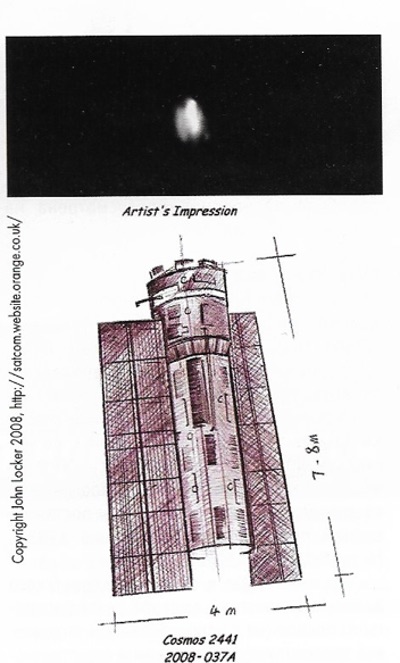 Ground-based image and artist’s impression of the first Persona satellite. (credit: John Locker) (the referenced website is no longer online) |
A civilian outgrowth of Persona may be Resurs-PM, which should start replacing the currently operating Resurs-P remote sensing satellites in 2023. The orbit announced for these satellites is virtually identical to that of Persona. The bus likely is very similar, although the solar panels are configured differently. Like Persona, Resurs-PM will use a LOMO telescope with a 1.5-meter primary mirror, but the optical assembly is different, using a two-mirror Ritchey-Chrétien telescope.
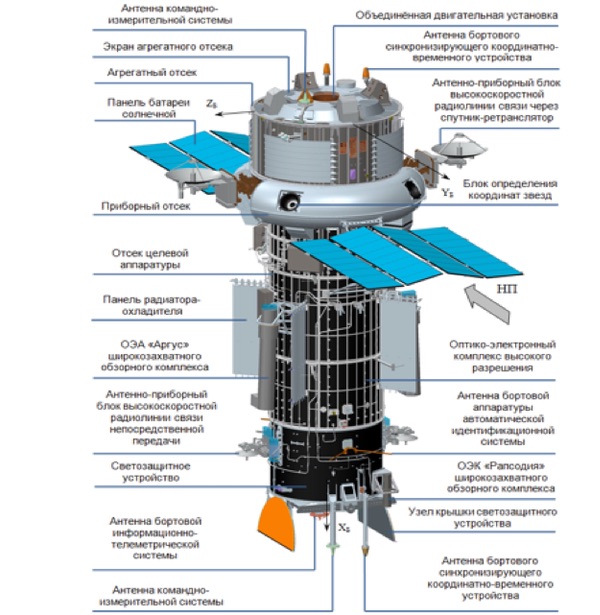 The Resurs-PM remote sensing satellite. (credit: RKTs Progress) |
Despite the trouble-plagued start of the Kosmos-2486 and Kosmos-2506 missions, both satellites seem to have been operating normally ever since. However, if their design lifetime is indeed five years, both have exceeded it by now. While they may well continue to operate for several more years, Russia cannot afford the risk of losing the high-resolution imaging capability offered by these satellites and is busily working on an upgrade of its spy satellite fleet.
In August 2016, the Russian newspaper Kommersant revealed the existence of a replacement for Persona called Razdan, which is the name of a river in Armenia that flows through the nation’s capital Yerevan (two earlier Russian digital reconnaissance satellites, Neman and Araks, had also been named after rivers in what are now former Soviet republics.) Referring to “two informed industry sources” as well as publicly available procurement documentation, the newspaper said the first three Razdan satellites were expected to fly in 2019, 2022, and 2024 and that the third would be the first to carry an optical system built by the Krasnogorsk Zverev Factory (PAO KMZ, further referred to here as KMZ) with a mirror having a diameter of more than two meters.[6] No more details on the project emerged in the Russian press after the publication of the Kommersant article. However, a considerable amount of information on the project can be extracted from a variety of Russian online sources.
Publicly accessible procurement documents show that the project officially began on June 19, 2014, with the signing of a contract between the Ministry of Defense and RKTs Progress. A second contract for the project was concluded by the same two parties on September 26, 2016. Possibly, the original contract only called for finishing the preliminary design of the satellite and the second one was for the actual construction of the satellites. This would explain why immediately following the signing of the 2014 contract, the design of some systems was assigned to more than one subcontractor, apparently on a competitive basis.
While the individual satellites are referred to with the military code name 14F156, the code name for the overall project (the “space system” in Russian terminology) is 14K046. As can be inferred from an online RKTs Progress document, the design of the satellite takes place in RKTs Progress’ Department 1032 under the leadership of chief designer Oleg G. Fedorenko.[7]
Razdan’s optical payload (the so-called “electro-optical complex” or OEK) is named Sevan, after the Armenian lake from which the Razdan river originates. RKTs Progress signed contracts for Sevan’s preliminary design in July 2014 with two telescope manufacturers, KMZ and LOMO.[8] However, there is no trace of LOMO in later documentation on Sevan, indicating that KMZ was selected as the sole provider. Unlike LOMO, KMZ is part of the powerful Shvabe holding, which unites several dozens of organizations that form the core of Russia’s optical industry. That may have helped it secure the prestigious contract for Sevan, while LOMO had to content itself with a contract for the Resurs-PM telescope, which in some ways is a repetition of the work it did earlier for Persona. Despite Kommersant’s claim that the KMZ telescope would be introduced only on the third Razdan satellite, it is much more likely that all the satellites will carry one and the same optical payload.
It would appear that KMZ began developing the technology for Razdan’s optical payload even before the project officially got underway. In December 2013 it won a tender organized by Roskosmos under the name Zerkalo-KT (“zerkalo” means “mirror” and “KT” stands for “space telescope”). The purpose of this was described as “the development of technology to manufacture lightweight primary mirrors for advanced large-size and very high-resolution space telescopes for remote sensing of the Earth.”[9]
| All this means that the size of Sevan’s primary mirror equals that of the one believed to have been introduced on America’s KH-11/KENNEN satellites back in 1976. |
The goal was to design a mirror with a diameter of up to 2.5 meters as well as a composite structure to house the mirror. These would have to be capable of lasting at least seven years in orbit. Judging from the documentation, Zerkalo-KT came to a premature end in February 2015, but it is obvious from other sources that KMZ continued work on the system in later years. A possible explanation for this is that Zerkalo-KT started out as a civilian project financed by Roskosmos and that the space agency stopped the money flow in early 2015 once the mirror became incorporated into the Ministry of Defense’s Razdan project. A drawing of the mirror conceived under Zerkalo-KT was published in an article in late 2014 (see the drawing at the top of this article).[10]
As can be determined from online procurement documents, KMZ received the final go-ahead for developing Sevan on September 30, 2016, four days after the Ministry of Defense and RKTs Progress signed their second contract for Razdan. As a payload supplier, KMZ would be expected to act as a subcontractor to RKTs Progress, but instead it received the contract directly from the Ministry of Defense, which apparently wants to place the development of Sevan under its direct supervision.
While KMZ is responsible for integration of the optical payload, the mirrors are built by the Lytkarino Optical Glass Factory (LZOS). LZOS had already teamed up with KMZ for the Zerkalo-KT project in 2014, possibly even before Razdan was approved.[11] At least two publications by LZOS acknowledge its involvement in Razdan.[12] Some issues of the company’s corporate magazine “Spektr” clearly refer to Sevan’s mirrors without mentioning the project by name. One mentions “a set of special-purpose optics” consisting of a 2.4-meter primary mirror, a 0.54-meter aspherical secondary mirror and an aspherical off-axis tertiary mirror.[13] This most likely means Razdan’s telescope is a Korsch three-mirror anastigmat.
Other issues of “Spektr” mention a container needed to transport a 2.35-meter mirror, which must be the exact diameter of the primary mirror (2.4 meters being a rounded number).[14] This is confirmed by procurement documents that can be linked to Sevan and contain drawings of all three mirrors inside their containers. From these the diameter of the tertiary mirror can be estimated at about 0.40 meters.[15]
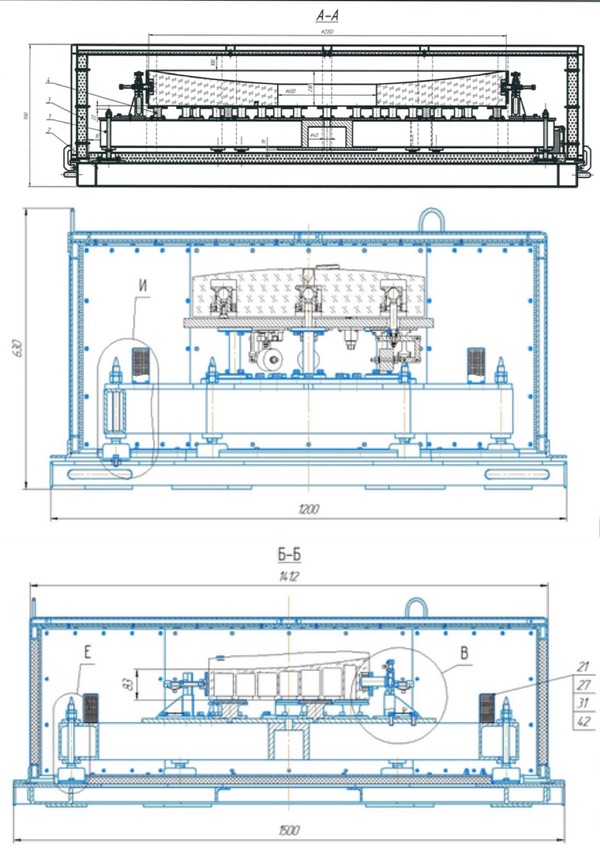 Drawings of Sevan’s primary, secondary and tertiary mirrors in their transport containers. (credit: Russia’s government procurement website) |
All this means that the size of Sevan’s primary mirror equals that of the one believed to have been introduced on America’s KH-11/KENNEN satellites back in 1976. It also has almost exactly the same diameter as the two primary mirrors that the US National Reconnaissance Office donated to NASA in 2012 for use aboard astronomical satellites (one of which will fly on the Nancy Grace Roman Space Telescope, earlier known as the Wide Field Infrared Survey Telescope). This was spare hardware left over from an NRO spy satellite project. The donated mirrors were reported to be part of a three-mirror assembly, but the tertiary mirror was not included in the donation.
The similar diameter of Sevan’s primary mirror does not necessarily translate into the same ground resolution as that achieved by America’s spy satellites. Other factors that come into play are the quality of the mirror and the image sensors. The material used for the construction of the primary mirror (and, presumably, the others as well) is SO-115M, also known as Sitall or Astrositall. This is a crystalline glass-ceramic material developed back in the Soviet days and has been used for many Russian space-based mirrors, including the 1.5-meter mirrors flown on Araks and Persona. LZOS publications acknowledge that materials such as silicon carbide (used by ESA’s Herschel and Gaia observatories) and beryllium (used by the James Webb Space Telescope) are superior in performance, but they point to the relatively low cost of Sitall and its ultra-low coefficient of thermal expansion.[16]
The CCD image sensors to be used by Sevan have been identified as Kem-PKh (for panchromatic imaging) and Kem-MS (for multispectral imaging).[17] Kem is the name of a river in the Republic of Karelia in the northwest of Russia. The sensors are manufactured by NPP Elar, which has also produced CCDs for other Russian Earth imaging satellites, including Persona, Resurs-P and Resurs-PM. Papers published by NPP Elar give a 9x9 µm² pixel size for Kem-PKh and an 18x18 µm² pixel size for Kem-MS. The same CCD pixel sizes are seen for Resurs-PM’s high-resolution panchromatic imaging system and medium-resolution multispectral imaging system, suggesting a commonality in design.[18]
Razdan’s main propulsion system uses a liquid-fuel engine developed by KB Khimmash, which is part of the Khrunichev Center.[19] From available data it would appear to be a modified version of the engine unit flown on the Resurs-P satellites. The satellites will also carry an electric propulsion system. The manufacturer of that cannot be established with certainty, but it is known that a company called NIIMash was tasked with building xenon tanks for the system.[20] According to one NIIMash document, the system will be used for fine orbit adjustments and make it possible to increase the ground resolution of the on-board optical complex.[21] This most likely means that Razdan’s perigee will at least periodically drop to altitudes where an electric propulsion system is needed to counter atmospheric drag. This is reminiscent of tests conducted in 2017–2019 by Japan with an experimental imaging satellite called Tsubame or Super Low Altitude Test Satellite, which used xenon-fueled ion thrusters to fight against aerodynamic drag as it dropped to altitudes as low as 167 kilometers. Presumably, the Razdan satellites will fly in elliptical orbits similar to those used by the America’s digital reconnaissance satellites, rather than the 730-kilometer circular orbits used by Persona.
Also on board will be control moment gyroscopes that enable the satellites to orient themselves without consuming propellant. These are provided by the Scientific Research Institute of Command Instruments (NIIKP) in St.-Petersburg. Called SGK-250, they have the same performance as gyroscopes flown on the Resurs-P and Persona satellites and will also be installed on Resurs-PM.[22]
One other subcontractor for the Razdan project is the Scientific Research Institute of Precision Mechanics (NII TM), which is developing a so-called “Information Elimination System” (SLI).[23] This is defined on the company’s website as an autonomously operating system that can erase information (including what is called “coded information”) in case certain parameters “exceed acceptable limits” and apparently contains a set of specialized sensors to continuously monitor various on-board systems.
Although Razdan’s optical payload likely is heavier than that of Persona, the satellites should still remain within the launch capacity of the Soyuz-2-1b, the most powerful rocket in the Soyuz launch vehicle family and the one also used to launch the Persona satellites. The heavier mass of the satellite may be compensated by the use of an elliptical rather than a circular orbit. The launches will take place from the Plesetsk military cosmodrome.
| Writing in a blog in late 2016, a VNIIEM designer said the excellent images returned by the first SkySat in 2013 had led Russian companies (including ISS Reshetnev) to begin drawing up plans for similar small satellites in 2014. |
Procurement documentation suggests that two Razdan satellites are currently under construction. Documentation released in September 2017 pointed to possible launch dates in late 2020 and late 2021, but these dates are likely to have slipped since then.[24] Aside from possible technical problems, Razdan, like many other Russian space projects, may well have suffered delays due to both budgetary issues and Western-imposed sanctions that have complicated the supply of foreign-built electronic components for the Russian space industry. Work is now underway on a much smaller type of spy satellite that is presumably supposed to guarantee continued access to high-resolution imagery for Russia’s military even if the Persona satellites fail in orbit before Razdan can be readied for launch.
On March 29, 2018, Russia launched a small military satellite from Plesetsk using the Soyuz-2-1v, a lightweight version of the Soyuz rocket without the four strap-on boosters. Announced as Kosmos-2525, it was placed into an orbit of roughly 320 by 350 kilometers with an inclination of 96.64°. Online tenders for the transportation of the satellite to Plesetsk identified it as EMKA and linked it to the All-Russian Scientific Research Institute of Electromechanics (VNIIEM), a builder of Earth remote sensing and meteorological satellites. The documents traced the project back to a contract signed between the Ministry of Defense and VNIIEM on October 23, 2015.[25]
VNIIEM’s annual report for 2016 deciphered EMKA as “Experimental Small Satellite”, adding that it would serve as the basis for a “space-based Earth remote sensing complex”, clearly used here as a cover term for military photographic reconnaissance.[26] EMKA likely is the same satellite identified in a handful of VNIIEM articles in 2014–2015 as Zvezda (“star”). One of those described it as a 150-kilogram experimental precursor of a slightly bigger 250-kilogram satellite (MKA-V) that can make high-resolution images for both civilian and military purposes. MKA stands for “small satellite” and “V” for “high resolution”. The article compares Zvezda and MKA-V to the first in a series of American commercial Earth imaging satellites called SkySat-1 with a maximum resolution of 0.9 meters in panchromatic mode. It also has a drawing of MKA-V, showing that it has the same resolution and is very similar in design to SkySat.[27]
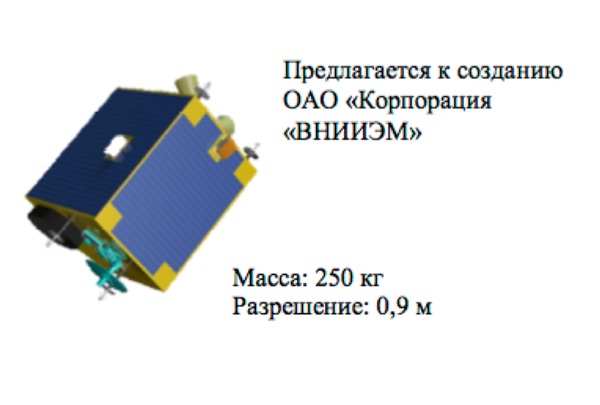 MKA-V satellite. (credit: VNIIEM) |
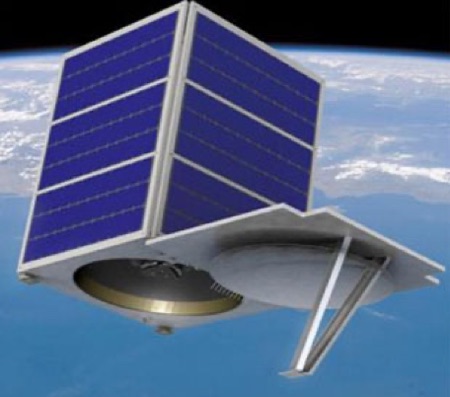 SkySat-1. (credit: Planet Lab) |
Zvezda is also mentioned on the website of a company called SKTB Plastik, which has drawings of a camera housing that it built for the satellite.[28] The shape and size of the housing exactly match those of a high-resolution camera described in two articles published in 2015, which said it was a payload for another small high-resolution satellite called ISS-55, proposed at the time by ISS Reshetnev, best known as a manufacturer of communications and navigation satellites.[29] Built by the Belarusian optical company OAO Peleng, the camera has a maximum resolution of 0.9 meters in panchromatic mode, identical to that of SkySat-1. Writing in a blog in late 2016, a VNIIEM designer said the excellent images returned by the first SkySat in 2013 had led Russian companies (including ISS Reshetnev) to begin drawing up plans for similar small satellites in 2014.[30]
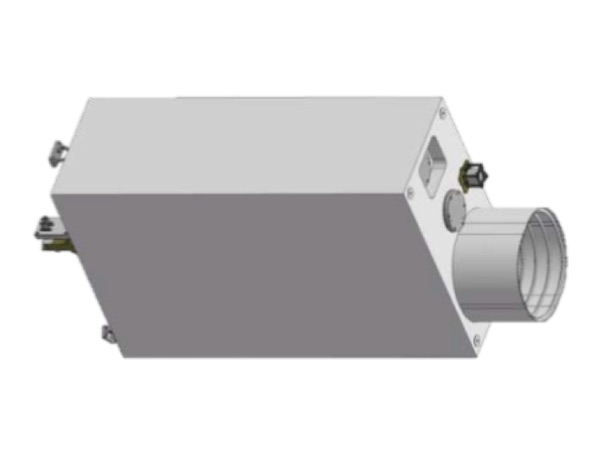 High-resolution camera designed for both the Zvezda and ISS-55 satellites. (credit: Trudy MAI) |
What can be deduced from all this with a fairly high degree of certainty is that the first SkySat launches in 2013 and 2014 inspired both VNIIEM and ISS Reshetnev to design small high-resolution remote sensing satellites (Zvezda and ISS-55) with an identical optical payload of OAO Peleng. These may initially have been proposed as civilian remote sensing satellites to Roskosmos, but also drew the attention of the Ministry of Defense, which selected the Zvezda satellite for further development in late 2015, renaming it EMKA. This would also explain why no more descriptions of Zvezda can be found in open literature after 2015.
Kosmos-2525 is still operational, continuing to perform regular burns to protect its orbit from decay. One of the objectives of the mission has been to observe ground-based optical calibration targets developed at the Moscow Polytechnic University.[31]
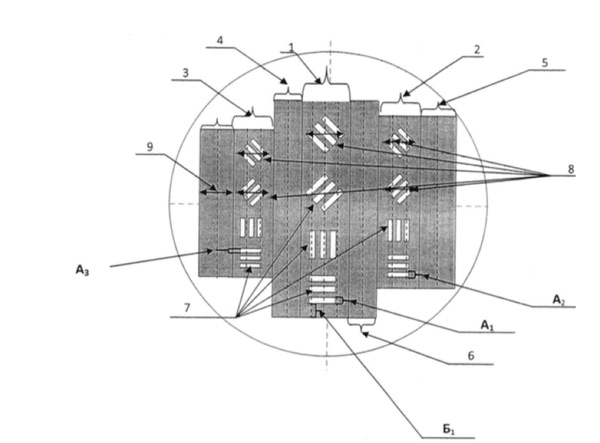 Drawing from a patent showing calibration targets likely used by the EMKA/Kosmos-2525 satellite. |
The targets function like an eye chart. The smallest group of bars that can be resolved marks the limit of the resolution for the optical instrument that is being used. Similar calibration targets are seen at several locations in the United States (for instance, at Edwards Air Force Base), but a novelty of the new targets is that they are not painted on asphalt, but on foldable polymer sheets that can be used at a variety of locations.
The operational successor of Kosmos-2525 is probably being developed under a project identified in procurement documents as Razbeg (“running start”), assigned to VNIIEM by the Ministry of Defense on November 1, 2016.[32] Available documents only reveal that Razbeg is a small satellite and also suggest it shares some design features with EMKA, indicating it is the same satellite that was named MKA-V in the earlier mentioned VNIIEM publication. Most likely, Razbeg is a constellation of small imaging satellites that, if necessary, can bridge the gap between Persona and Razdan and ultimately augment the imagery provided by the big spy satellites. Similarly, the US National Reconnaissance Office supplements the imagery collected by its own satellites with lower resolution photographs obtained from operators of commercial remote sensing satellites.
A key component of any real-time satellite imaging system is a network of data relay satellites that can relay images from reconnaissance satellites during the long periods of time that they are not in view of ground stations. The Persona satellites have operated in conjunction with two military data relay satellites named Garpun (“harpoon”), also known as 14F136. Built by ISS Reshetnev, they were launched in September 2011 and December 2015 after many years of delays (the project was initiated in 1993). The second satellite is known to have been used for laser communication experiments with the third Persona satellite using an on-board laser terminal called LT-150. Only two of the Garpun satellites were manufactured and their design lifetime is unknown. A constellation of at least three satellites would be required to provide full-time coverage.
| Complicating matters further, Russia currently has no radar imaging satellites (neither civilian nor military) capable of seeing through cloud cover and making observations at night. |
ISS Reshetnev is currently working on new military communications satellites called Gerakl (“Hercules”) and Ispolin (“giant”), which will carry large antennas under development at the company. The biggest of these has a diameter of 48 meters, although it is not known for sure if this is intended for either of these satellites. Gerakl was described by one source as a data relay satellite and is likely to be the successor of Garpun.[33] The Gerakl project began in 2014, but there are no signs that it is anywhere near launching its first satellite. The satellites will have to be orbited by the Angara-A5 rocket, which is slated to resume its test flights from Plesetsk later this year after a six-year hiatus. Russia also has three Luch-5 data relay satellites in geostationary orbit, but these were ordered by Roskosmos and it is not clear if they are used to relay information from Ministry of Defense satellites. ISS Reshetnev recently was awarded a contract for an improved version of these satellites called Luch-5VM, which is not expected to fly until 2024. No specific mention of a relay capability for military satellites is made in the technical specifications for Luch-5VM.
Russia is relying on two aging Persona satellites to provide high-resolution imagery in the interests of the Ministry of Defense. Both seem to be functioning normally after having overcome significant problems during initial in-orbit testing. However, there is no guarantee they will continue to operate until the next-generation Razdan satellites are ready to take over. This may be the reason why a decision was made to develop a much smaller and simpler type of spy satellite (Razbeg) that could help bridge the gap to Razdan and eventually complement the imagery provided by the big satellites. The likely experimental precursor of these satellites (EMKA/Kosmos-2525) reached the launch pad just 2.5 years after being approved, suggesting the operational satellites may also be ready to fly relatively soon. Still, the resolution offered by the smaller satellites will not match that of Razdan. The Ministry of Defense also operates two four-ton observation satellites called Bars-M (launched as Kosmos-2503 and 2515), but these are used for low-resolution cartographic imaging.
Complicating matters further, Russia currently has no radar imaging satellites (neither civilian nor military) capable of seeing through cloud cover and making observations at night. NPO Lavochkin is working on a series of dedicated military radar imaging satellites called Araks-R, but it is unknown when they will fly. A new generation of specialized military data relay satellites needed to support the reconnaissance satellite program may also be some time away from entering service. In short, it is safe to say that Russia’s current space reconnaissance capabilities are far inferior to those of the United States and China. In a worst-case scenario, the Russian Ministry of Defense may even find itself depending solely on lower resolution imagery from Russian civilian Earth remote sensing satellites until its new fleet of reconnaissance satellites is ready to take to the skies.
For more details, see threads on Razdan, ЕМКА and Razbeg on the NASA Spaceflight Forum. These are updated with new information as it becomes available.
Note: we are temporarily moderating all comments submitted to deal with a surge in spam.